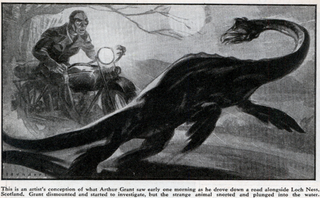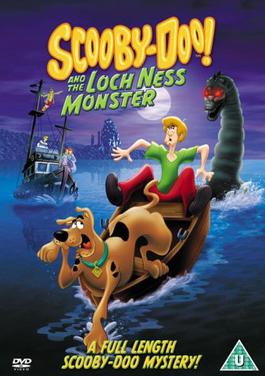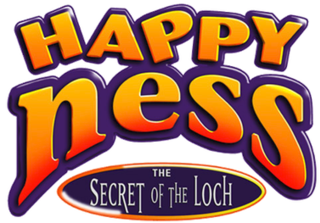
The Loch Ness Monster, affectionately known as Nessie, is a mythical creature in Scottish folklore that is said to inhabit Loch Ness in the Scottish Highlands. It is often described as large, long-necked, and with one or more humps protruding from the water. Popular interest and belief in the creature has varied since it was brought to worldwide attention in 1933. Evidence of its existence is anecdotal with a number of disputed photographs and sonar readings.

Incident at Loch Ness is a 2004 mockumentary starring, produced by and written by Werner Herzog and Zak Penn, while also serving as the latter's directorial debut. The small cast film follows Herzog and his crew while working on the production of a movie project on the Loch Ness Monster titled Enigma of Loch Ness. Incident at Loch Ness won the New American Cinema Award at the 2004 Seattle International Film Festival.
The Family-Ness is a cartoon series from Scotland first produced in 1983. It was originally broadcast on BBC One from 5 October 1984 to 5 April 1985, with repeats airing throughout most of the 1990s and early 2000s, eventually ending with a short run on CBeebies on BBC Two between 11 and 22 February 2002. It was created by Peter Maddocks of Maddocks Cartoon Productions. Maddocks later went on to produce Penny Crayon and Jimbo and the Jet Set in a similar style. Family-Ness was about the adventures of a family of Loch Ness Monsters and the MacTout family, particularly siblings Elspeth and Angus. The 'Nessies' could be called from the loch by the two children by means of their "thistle whistles".
Terror of the Zygons is the first serial of the thirteenth season of the British science fiction television series Doctor Who, which was the first broadcast in four weekly parts on BBC1 from 30 August to 20 September 1975. The serial featured the last regular appearance by Ian Marter as companion Harry Sullivan and Nicholas Courtney as Brigadier Lethbridge-Stewart. The serial is the first appearance of the Zygons.

The Loch Ness Monster is a creature from folklore that has appeared in popular culture in various genres since at least 1934. It is most often depicted as a relict dinosaur or similar, but other explanations for its existence such as being a shapeshifter or from outer space also appear. It is only occasionally portrayed as threatening, despite its name.

Phyllis Logan is a Scottish actress, widely known for her roles as Lady Jane Felsham in Lovejoy (1986–1993) and Mrs Hughes in Downton Abbey (2010–2015). She won the BAFTA Award for Most Promising Newcomer for the 1983 film Another Time, Another Place. Her other film appearances include Secrets & Lies (1996), Shooting Fish (1997), Downton Abbey (2019) and Misbehaviour (2020).

Loch Ness is a 1996 family drama film starring Ted Danson and Joely Richardson. It was written by John Fusco and directed by John Henderson.

Scooby-Doo! and the Loch Ness Monster is a 2004 direct-to-video animated comedy mystery film, and the seventh direct-to-video film based upon the Scooby-Doo Saturday morning cartoons. It was released on June 22, 2004, and it was produced by Warner Bros. Animation. Unlike the previous two films, it is not in the "classic format", and does not have the 1969 voice cast, and instead has Mystery Inc. voiced by their regular voice actors, and has them wearing their outfits from What's New, Scooby Doo?. It is also the first film to have Mindy Cohn voice Velma Dinkley, the What's New, Scooby Doo? theme song, and the film has Grey DeLisle returning to voice Daphne Blake since Scooby-Doo and the Cyber Chase.

Chill Out, Scooby-Doo! is a 2007 animated direct-to-DVD comedy mystery film, and the eleventh in the Scooby-Doo direct-to-video film series, produced by Warner Bros. Animation, It was released to DVD on September 4, 2007. The film is dedicated to Iwao Takamoto, a character designer for Hanna-Barbera who died on January 8, 8 months before the film's home video release. This was also the final Scooby-Doo! movie that Joseph Barbera worked on before his death on December 18, 2006.
Monster Mash is a 2000 Italian-American direct-to-video animated musical comedy horror film co-produced by DIC Entertainment, L.P. and Rai Fiction. It is an original story, based on the lore of Frankenstein, the Wolfman, and Count Dracula.

The Ballad of Nessie is a 2011 traditionally animated short film produced by Walt Disney Animation Studios. It was directed by Stevie Wermers-Skelton and Kevin Deters, and produced by the team behind Disney's 2007 animated short film How to Hook Up Your Home Theater.

What a Whopper is a 1961 British comedy film directed by Gilbert Gunn and starring Adam Faith, Sid James and Carole Lesley. It was written by Terry Nation from an original script by Jeremy Lloyd.
The Mysterious Monsters is a 1976 documentary film written and directed by Robert Guenette about the cryptids Bigfoot, the Loch Ness Monster, and the Yeti. It contained content from Guenette’s made-for-TV movie Monsters! Mysteries or Myths? that aired on CBS on November 25, 1974. That version had been produced by David L. Wolper in cooperation with the Smithsonian Institution and was narrated by Rod Serling.
Events in 1992 in animation.
Marmaduke Arundel "Duke" Wetherell was a British–South African actor, screenwriter, producer, film director and big-game hunter. He was responsible for the hoax "surgeon's photograph" of the Loch Ness Monster.

Happy Ness: The Secret of the Loch is a children's cartoon that aired in 1995, centering on a community of Loch Ness monsters that could fly and swim. It lasted 13 episodes, but also airing in Sweden and other countries on Fox Kids and Fox Kids Play. It was co-produced by Abrams Gentile Entertainment, C&D, and AB Productions. In the United States, it was syndicated by Active Entertainment.

The Water Horse: Legend of the Deep is a 2007 fantasy drama film directed by Jay Russell and written by Robert Nelson Jacobs, based on Dick King-Smith's children's novel The Water Horse. It stars Alex Etel as a young boy who discovers a mysterious egg and cares for what hatches out of it: a "water horse" which later becomes the fabled Loch Ness Monster. The film also stars Emily Watson, Ben Chaplin and David Morrissey.

The Secret of the Loch is a 1934 British film about the Loch Ness Monster. It is the first film made about the monster. It was edited by David Lean.

The Frog Kingdom is a 2013 Chinese animated adventure drama film directed by Nelson Shin. A United States dub of the film was released on video on demand and on DVD in the United States on June 30, 2015, by Lionsgate and Grindstone Entertainment Group.













